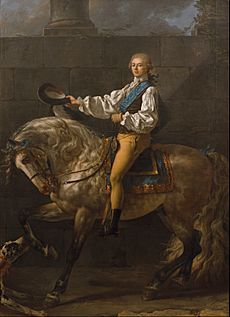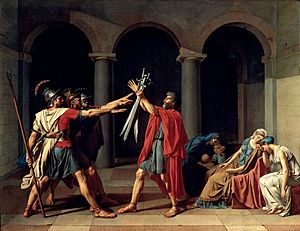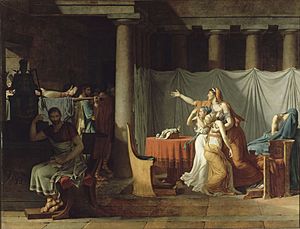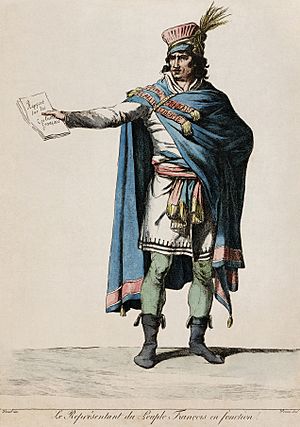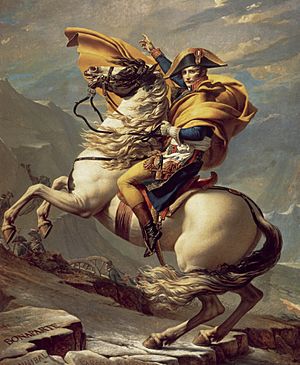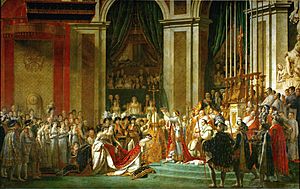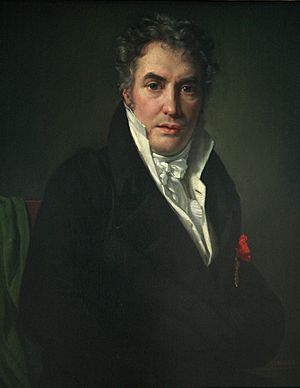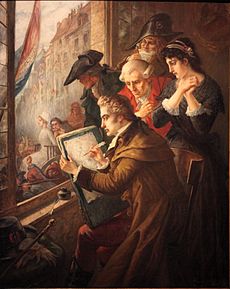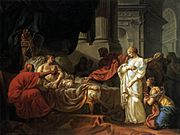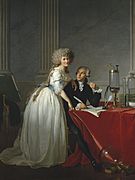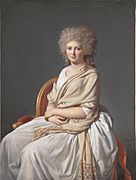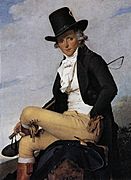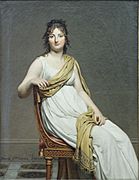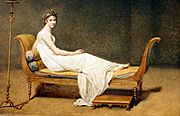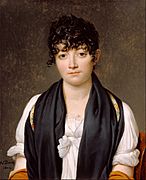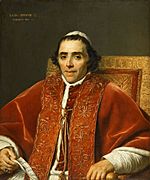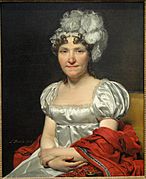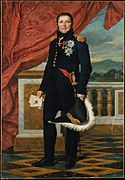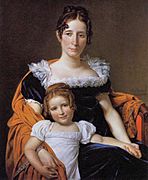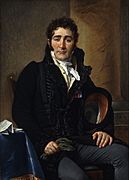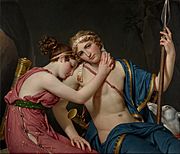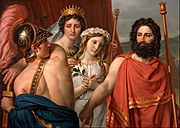Jacques-Louis David facts for kids
Quick facts for kids
Jacques-Louis David
|
|
|---|---|
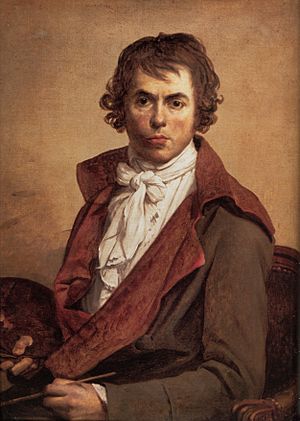
Self-portrait, 1794 (Musée du Louvre)
|
|
| 33rd President of the National Convention | |
| In office 5 January 1794 – 20 January 1794 |
|
| Preceded by | Georges Auguste Couthon |
| Succeeded by | Marc Guillaume Alexis Vadier |
| Personal details | |
| Born | 30 August 1748 Paris, Kingdom of France |
| Died | 29 December 1825 (aged 77) Brussels, United Kingdom of the Netherlands |
| Political party | The Mountain |
| Spouses |
Marguerite Charlotte Pécoul
(m. 1782; div. 1793)
(m. 1796) |
| Alma mater | Collège des Quatre-Nations, University of Paris |
| Awards |
|
| Signature | |
Jacques-Louis David (30 August 1748 – 29 December 1825) was a famous French painter. He was known for his Neoclassical style, which was popular in his time. In the 1780s, his paintings helped change art from the fancy Rococo style to a more serious, classical look. This new style matched the mood of France before the French Revolution.
David later became a strong supporter of the French Revolution. He was a friend of Maximilien Robespierre, a key leader. David became very powerful in the arts during the French Republic. After Robespierre lost power, David was put in prison. When he was released, he supported Napoleon, who was then the First Consul of France. David developed a new art style called the Empire style, using warm colors. After Napoleon was defeated, David moved to Brussels, in what is now Belgium. He lived there until he died. David taught many students, and he greatly influenced French art in the early 1800s.
Contents
Early Life and Art Training
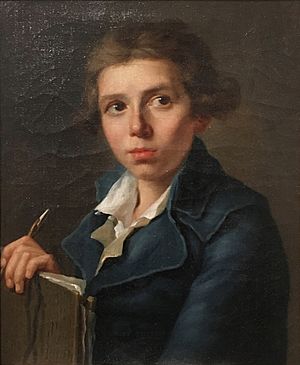
Jacques-Louis David was born in Paris, France, on August 30, 1748. His family was wealthy. When he was about nine, his father died in a duel. His mother left him with his rich uncles, who made sure he got a good education. He went to the Collège des Quatre-Nations at the University of Paris.
David was not a good student in school. He had a facial tumor that made it hard for him to speak. He was always busy drawing in his notebooks. He once said he was "always hiding behind the instructor's chair, drawing." He wanted to be a painter, but his family wanted him to be an architect.
He convinced his family and went to study with François Boucher, a leading painter. Boucher was a Rococo painter, but art styles were changing. Boucher sent David to his friend, Joseph-Marie Vien, who liked the new classical style. David then attended the Royal Academy, which was located in the Louvre.
Winning the Prix de Rome
Each year, the Academy gave a special award called the Prix de Rome. This award paid for a student to live in Rome for 3 to 5 years. Artists were studying classical styles again, so this trip was a great chance to see ancient Roman art. It also allowed them to study works by Italian Renaissance masters.
David tried three times to win the prize but failed. After his second loss in 1772, he went on a hunger strike for two and a half days. His teachers encouraged him to keep painting. Finally, in 1774, David won the Prix de Rome. His winning painting was Erasistratus Discovering the Cause of Antiochus' Disease. In October 1775, he traveled to Italy with his mentor, Joseph-Marie Vien.
While in Italy, David studied artists like Poussin and Caravaggio. He filled many sketchbooks with drawings. He met Anton Raphael Mengs, who taught him to study classical art carefully. Mengs also introduced David to the writings of Johann Joachim Winckelmann, a famous art historian. In 1779, David visited the ancient ruins of Pompeii. This trip made him believe even more in the power of classical art.
Early Artworks and Themes
David's fellow students recognized his talent, even if he was hard to get along with. His stay in Rome was extended by a year. In 1780, he returned to Paris and became an official member of the Royal Academy. Two of his paintings were shown in the important Salon exhibition of 1781. Famous painters praised his work.
The King gave David a place to live in the Louvre, a special honor for great artists. David married Marguerite Charlotte Pécoul, the daughter of a royal building contractor. This marriage brought him money and they had four children. David had about 50 students of his own.
He was asked to paint "Horace defended by his Father" for the government. But David felt he could only paint Roman subjects in Rome. His father-in-law paid for the trip, and David went back to Rome with his wife and three students.
The Oath of the Horatii
In Rome, David painted his famous Oath of the Horatii in 1784. This painting shows ideas from the Enlightenment. It also hints at Rousseau's idea of a social contract. The painting focuses on the idea of citizens being loyal to their country. The three sons are shown ready to fight for their city.
The women in the painting look sad and are separated from the men. David shows the father with his back to them, keeping them out of the oath. This painting highlights the different roles men and women had in society at that time. Men were seen as strong and disciplined, while women were shown as emotional.
These ideas about loyalty and sacrifice also appear in Distribution of Eagles. While Oath of the Horatii shows sacrifice for one's country, Distribution of Eagles shows sacrifice for an Emperor like Napoleon.
The Death of Socrates
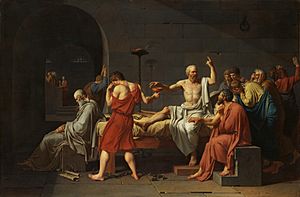
In 1787, David wanted to become the Director of the French Academy in Rome. He did not get the job because he was considered too young. This made him angry at the Academy.
For the Salon of 1787, David showed his famous painting The Death of Socrates. It shows Socrates, a wise Greek philosopher, calmly discussing the soul before drinking poison. His friends and students are around him, sad. Critics loved this painting, calling it "perfect." It fit the political mood of the time.
Brutus and the Revolution
David's next painting was The Lictors Bring to Brutus the Bodies of His Sons. This painting was very popular. The French Revolution had just started. The National Assembly was formed, and the Bastille prison had fallen.
The royal court did not want paintings that might stir up the people. So, all paintings had to be checked before being shown. David's portrait of Lavoisier, a chemist and a member of the Jacobin party, was banned. But when newspapers reported this, people were angry. The painting of Brutus was then allowed to be shown. Art students even protected it.
The painting shows Lucius Junius Brutus, a Roman leader, grieving for his sons. His sons tried to bring back the monarchy, so Brutus ordered their deaths to protect the republic. Brutus was seen as a hero who sacrificed his own family for his country. This painting became a symbol of the Republic and civic virtue during the Revolution.
David and the French Revolution
David strongly supported the French Revolution. He was a friend of Robespierre and a member of the Jacobin Club. While many rich people left France, David stayed to help change the old system. He even voted for the execution of King Louis XVI. Some believe his love for classical Roman ideas made him support a republic.
David also criticized the Royal Academy of Painting and Sculpture. This was likely because of their old-fashioned rules and how they had treated him before. The Academy was controlled by royalists, who did not like David's ideas for change. The National Assembly eventually made the Academy change its rules.
David started creating art to support the new republic. His painting of Brutus was shown during a play about Brutus by Voltaire.
The Unfinished Tennis Court Oath
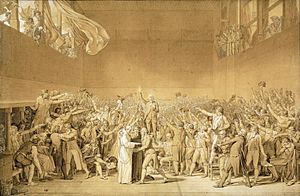
In 1789, David began a painting called The Oath of the Tennis Court. He was asked to create this painting to remember an important event. The painting was meant to show the unity of the people against the old government. However, David never finished it.
The event happened when members of the Third Estate (common people) formed the National Assembly. They were locked out of their meeting hall. So, they met in a tennis court and swore an oath not to stop until they created a new constitution. This was a big moment for national unity. David joined the Jacobins after this event.
The painting was planned to be very large. The figures in the front were meant to be life-sized portraits. David wanted funding from many people, but it was not enough. The state ended up paying for the project.
David started the painting in 1790, showing men united for a patriotic idea. The outstretched arms in this work, like in Oath of the Horatii, show David's belief that Roman-like virtues were happening in France. The stormy weather in the painting suggests the coming storm of the revolution.
However, the political situation in France changed too quickly. The unity shown in the painting no longer existed by 1792. The National Assembly split into different groups. Many of the "heroes" of 1789 were seen as "villains" by 1792. Because of this, David left the painting unfinished. After this, he used metaphors in his art instead of directly showing political events.
Revolutionary Festivals
When Voltaire died in 1778, the church would not bury him in a church. In 1791, David was put in charge of moving Voltaire's body to the Panthéon. This was a large parade through Paris. About 100,000 people watched the "Father of the Revolution" being moved. This was the first of many big festivals David organized for the new republic.
He also organized festivals for people who died fighting for the revolution. These events were like ancient Greek and Roman festivals. David used many revolutionary symbols in these events. One popular symbol he created was a figure of Hercules. This figure, usually a sign of the old monarchy, became a symbol of the people's power and protection of the Republic.
King's Execution and Marat's Death
In June 1791, King Louis XVI tried to escape France but was caught. He had asked the Austrian Emperor for help to get his throne back. This led to an invasion of France. The French people arrested the King. The Bourbon monarchy was destroyed in 1792.
When the new National Convention met, David sat with his friends Jean-Paul Marat and Robespierre. David soon became known as a "ferocious terrorist." Robespierre's agents found proof that the King was trying to overthrow the government. The National Convention put Louis XVI on trial. David voted for the King's death. Because of this, his wife, who supported the King, divorced him.
After Louis XVI was executed in January 1793, another man, Louis Michel le Peletier de Saint-Fargeau, was killed. He was killed by a royal bodyguard for voting for the King's death. David was asked to organize his funeral. David painted Le Peletier Assassinated. The painting showed a sword hanging over Le Peletier's body, symbolizing the danger of power. This painting was later destroyed.
On July 13, 1793, David's friend Marat was killed by Charlotte Corday. She pretended to have a list of enemies of France. Marat, a journalist and member of the National Convention, had a skin disease and worked in his bath. Corday killed him there. David again organized a grand funeral, and Marat was buried in the Panthéon.
The Death of Marat
The Death of Marat is perhaps David's most famous painting. It has been called the "Pietà of the revolution." When David showed the painting, he said, "Citizens, the people were again calling for their friend... David, take up your brushes... avenge Marat... I obeyed." David worked quickly, and the result was a powerful image.
The Death of Marat, painted in 1793, became a key image of the Reign of Terror. It made both Marat and David famous in the revolution. The painting shows Marat with the marks of his murder. David made him look like Christ, with a peaceful expression. The painting has a tombstone-like block in front and a holy light. It shows how David and Marat, though atheists, created a new kind of "religion" around the republic.
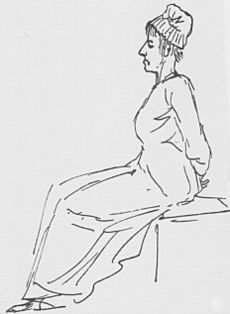
After the King's execution, France went to war with many European countries. David was part of the Committee of General Security, which helped lead the Reign of Terror. David organized his last big festival, the Festival of the Supreme Being. Robespierre wanted to create a new religion based on Rousseau's ideas. David helped with this by organizing these festivals.
Soon, the war went well for France. French troops moved into the Netherlands. Robespierre was then arrested and executed, ending the Reign of Terror. David was arrested twice, first in 1794 and again in 1795. He was mostly held in the comfortable Luxembourg Palace in Paris. There, he painted his own portrait and that of his jailer.
After the Revolution
David painted The Sabine Women Enforcing Peace by Running between the Combatants. This painting is said to honor his wife and show love winning over conflict. It was also seen as a call for people to unite after the revolution's violence.
For this painting, David developed a "Pure Greek Style," different from his earlier "Roman style." This new style was influenced by art historian Johann Joachim Winckelmann. David said Greek art had "noble simplicity and silent greatness." The figures in this painting were smoother and more feminine than his past works.
The story of the painting is about the Romans kidnapping Sabine women. Later, the Sabines attacked Rome. Hersilia, a Sabine woman married to the Roman leader, stood between the fighting groups. She begged them to stop the war.
During this time, many revolutionary statues were destroyed. When David was released from prison, France had changed. His wife helped him get out. He wrote to her, saying he still loved her, and they remarried in 1796. David then focused on his art, teaching students, and mostly stayed out of politics.
David and Napoleon
David had supported the Committee of Public Safety during the Terror. He signed the death warrant for Alexandre de Beauharnais. Beauharnais's widow, Joséphine, later married Napoleon Bonaparte and became Empress. David painted their coronation.
David admired Napoleon from their first meeting. He sketched Napoleon in 1797. Napoleon thought highly of David. He asked David to go with him to Egypt in 1798, but David refused. He preferred his comfortable life in France.
After Napoleon's successful takeover in 1799, he asked David to paint his daring crossing of the Alps. This crossing helped the French army win the Battle of Marengo. Napoleon had crossed the Alps on a mule, but he asked to be shown "calm upon a fiery steed." David painted Napoleon Crossing the Saint-Bernard.
When Napoleon became Emperor in 1804, David became the official court painter. He continued to teach students during this time.
The Coronation of Napoleon
One of David's most important commissions was The Coronation of Napoleon (1805-1807). David was allowed to watch the actual event. He had drawings of Notre Dame and had people involved in the coronation pose for him. Napoleon himself never posed for this painting. David did get Empress Joséphine and Napoleon's sister, Caroline Murat, to pose.
Pope Pius VII also posed for the painting and even blessed David. Napoleon visited David and praised the painting. David had to change parts of the painting because Napoleon changed his mind. For this huge work, David received a large sum of money.
David received several honors from Napoleon. He was made a Chevalier de la Légion d'honneur in 1803. He was promoted to an Officier in 1808 and a Commandeur in 1815.
Exile and Later Years
When the Bourbons returned to power in France, David was on a list of former revolutionaries and supporters of Napoleon. This was because he had voted for the execution of King Louis XVI. The new King, Louis XVIII, offered David a pardon and a job as court painter. But David refused. He chose to live in exile in Brussels, Belgium.
In Brussels, David taught artists like François-Joseph Navez. He painted mythological scenes and portraits of people from Brussels and French exiles. He lived quietly with his wife, whom he had remarried.
David created his last major work, Mars Being Disarmed by Venus and the Three Graces, from 1822 to 1824. In 1823, he wrote that this would be his last painting. He wanted it to be his best. The finished painting was shown in Brussels and then in Paris. His former students came to see it.
The exhibition made a lot of money. More than 10,000 people saw the painting. In his final years, David remained a skilled artist. Even after a stroke in 1825 affected his face and speech, he continued to paint. He worked on an improved version of his The Anger of Achilles. He told friends this painting was "killing" him because he was so determined to finish it. He completed it before he died.
David died on December 29, 1825, after being hit by a carriage. After his death, some of his portraits were sold for very little money in Paris. His famous Death of Marat was shown in a private room to avoid upsetting people. David was not allowed to be buried in France because he had voted to execute King Louis XVI. His body was buried in Brussels. Some say his heart was buried with his wife in Paris.
David's Legacy in Art
Jacques-Louis David was considered the leading painter in France during his time. Many famous painters after the French Revolution had been his students. For example, David's student Antoine-Jean Gros became a Baron and was honored by Napoleon. Another student, Jean Auguste Dominique Ingres, became a very important artist of the Neoclassical style.
Being a student of David was a great honor and gave artists a good reputation. He often had his advanced students help him with his large paintings.
After his death, David faced more criticism than during his life. People said his style was too stiff and lacked warmth. However, David had become famous by challenging the old rules of the French Royal Academy. His later works also showed his growth in the Empire style, which was more dynamic and colorful. Much of the criticism likely came from his enemies. David had a competitive personality and played a role in the Reign of Terror. He signed death warrants for many people, including King Louis XVI and Marie Antoinette.
One event that earned him much dislike was the execution of Emilie Chalgrin. A fellow painter asked David, who was powerful at the time, to help his sister, Chalgrin. She was accused of crimes against the Republic. David refused to help, and she was executed. This event stayed with him and affected his reputation.
In the last 50 years, David's art has become popular again. In 1948, his 200th birthday was celebrated with an exhibition of his works in Paris and Versailles. After World War II, Jacques-Louis David was seen as a symbol of French pride. He is also considered a key figure in the development of European and French art. The start of Romanticism in art is often linked to artists like David.
There are streets named after David in the French cities of Carcassonne and Montpellier.
Portraits by David
Besides his large history paintings, David also painted many portraits for private clients. His portraits were known for being truthful and realistic. He focused on showing the real features and personalities of his subjects. He did not try to make them look perfect, unlike his historical paintings where he made figures look like Greek and Roman ideals.
David put a lot of detail into his portraits. He carefully painted small features like hands and fabric. The backgrounds of his portraits were usually simple and dark. This helped the viewer focus only on the person in the painting.
His portrait of his wife (1813) is a good example of his portrait style. The dark background makes you focus on her. Her features are realistic. You can see the detailed satin of her dress, the folds of her scarf, and her hands.
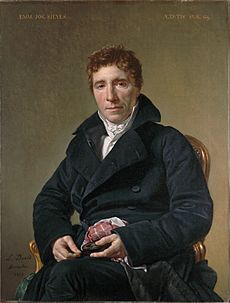
In his painting of Brutus (1789), the man and his wife are shown separately. This highlights the idea of patriotic sacrifice. Paintings like this made David a hero of the revolution.
In the Portrait of Antoine-Laurent Lavoisier and his wife (1788), the man and his wife are shown close together. She leans on his shoulder, and he looks at her. David used soft light in this painting, unlike the sharp light in his Brutus or Horatii paintings. Lavoisier was a famous chemist and a tax collector. He was later executed during the Reign of Terror. David, who was powerful then, did not help him.
Other portraits include paintings of his sister-in-law and her husband, Madame and Monsieur Seriziat. The portrait of Monsieur Seriziat shows a wealthy man with his horse-riding gear. The portrait of Madame shows her in a simple white dress, holding her child's hand. David painted these portraits to thank them for letting him stay with them after he was in prison.
Towards the end of his life, David painted a portrait of his old friend Abbé Sieyès. Both had been involved in the Revolution and survived the dangerous political times that followed.
Shift in David's Views
David's changing views affected his later paintings, including the one of Sieyès. During the peak of the Terror, David strongly supported radical leaders like Robespierre and Marat. He even offered his life to defend them. He organized revolutionary festivals and painted portraits of those who died for the revolution. He was a passionate speaker in the National Assembly.
However, after Robespierre was executed, David was imprisoned. His way of speaking changed. While in prison, he wrote many letters saying he was innocent. He wrote that he should never have left his art studio to become a legislator. He felt he had a good heart but lacked understanding for politics.
Later, when explaining his "Grecian style" for paintings like The Intervention of the Sabine Women, David talked more about this change in attitude. He said that in art, the strong and quick emotions appear first. Calmness and deep meaning come later. Only great artists achieve these deeper qualities.
Filmography
- Danton (Andrzej Wajda, France, 1982) – This is a historical drama film. Many scenes show David as a quiet character, watching and drawing. The movie focuses on the period of the Terror.
Gallery
-
Portrait of Antoine-Laurent Lavoisier and his wife (1788), Metropolitan Museum of Art, New York
-
Portrait of Anne-Marie-Louise Thélusson, Comtesse de Sorcy (1790), Neue Pinakothek, Munich
-
Portrait of Pierre Sériziat, (1795), Louvre Museum
-
Portrait of Madame de Verninac (1798–1799), born Henriette Delacroix, elder sister of Eugène Delacroix, Musée du Louvre, Paris
-
Madame Récamier (1800), Musée du Louvre, Paris
-
Portrait of Pope Pius VII (1805), Musée du Louvre, Paris
-
Marguerite-Charlotte David (1813), National Gallery of Art, Washington, D.C.
-
Étienne-Maurice Gérard (1816), Metropolitan Museum of Art, New York
-
The Comtesse Vilain XIIII and Her Daughter (1816), National Gallery, London
-
The Anger of Achilles (1819), Kimbell Art Museum
See also
 In Spanish: Jacques-Louis David para niños
In Spanish: Jacques-Louis David para niños
- Napoleon legacy and memory
- Neoclassicism in France



